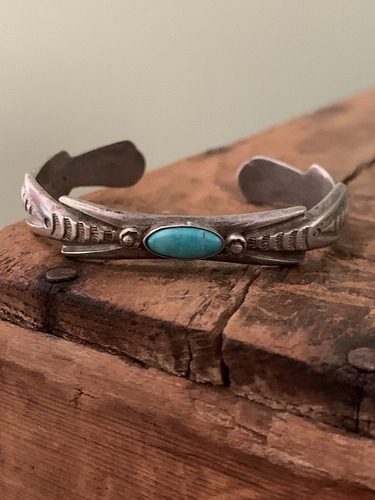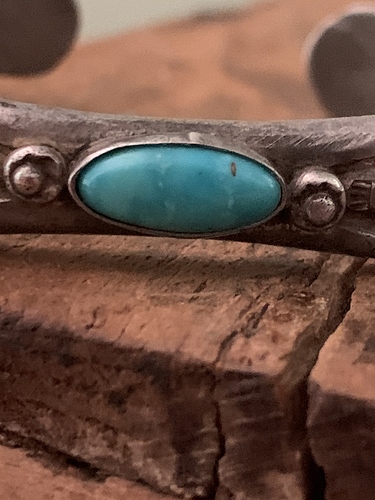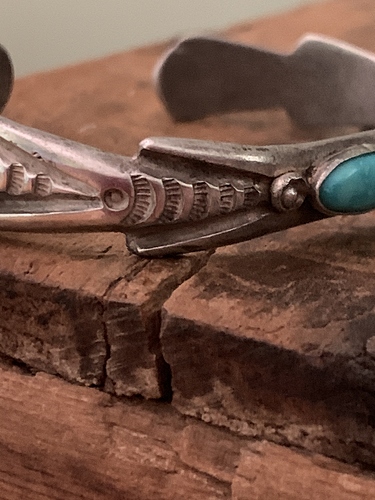I bought this piece online for $12. (Seller said She purchased it many moons ago at an antique store in California)
I thought the stone was pretty & possible turquoise.
It was VERY black with patina, I cleaned it up a little and I don’t see any markings. It’s quite heavy.
I have not tested it for Sterling yet, I’m curious if anyone has ever seen anything like it or any idea of age?
I attached before & after pic
Thanks
I love it! Great looking cuff!
And that was really neat looking! If I had to guess, I would like to say resembles a sandcast style but I leave that to the experts on this forum! What a great find, especially at that price.
Looks sand cast with Navajo style stamp work. Could be lost wax cast from a sand cast original, but suspect it is authentic sand cast, and most likely Navajo. Sand castings have to be individually quality stamped by hand after the casting process, and Navajo sand casters don’t always take the time to do this. It’s often left to the silversmith who does any additional work to the piece.
Sand casters don’t always use Sterling 92.5% silver quality either. Base color is fairly white, so it could be anything from ~75% silver on up.
Interesting…thanks for the info
Any idea on age?
Best guess is 70’s, although it could have been made anytime from the 70’s to early 2000’s. Stone looks like low quality stabilized turquoise, and needs to be removed and reset, or it will eventually fall out.
Great find, Tara. You likely got this bracelet for less than the value of the materials 
I’d say that is a really nice cuff!
Michael, could you please elaborate on how lost wax casting would be used to make a replica of a sand cast original? From what I understand about lost wax casting, you start with a wax original, in the positive. The wax positive is then used to make a negative mold out of plaster, then the wax is melted away and replaced with the casting metal. So my question then is how would you convert a bracelet into a wax replica of that bracelet?
I do understand how tufa cast originals can be replicated via a casting process using cement, as explained in this article by Jason which I copied into The Sandcast Thread:
But I’m assuming the process you’re referring to here is different?
Making a lost wax cast from a sand cast original is technically very simple. A rubber mold is made from the sand cast original, wax is injected into the mold to create an exact wax copy of the original, the wax copy is ‘invested’ into a material similar to plaster of Paris in a can like flask, the wax is then burned out of the investment in a kiln to create a void in the exact negative shape of the original. While the investment is still very hot and close to the melting temp of the material being cast, molten metal is either centrifugally forced into the void, or forced into the void with a powerful vacuum. Once the metal has cooled to a solid, the flask and investment are quenched in water, and the finished casting is removed.
I should add here that I consider making a mold copy of a craftsmans work for commercial distribution without attribution, or compensation to the original creator of that work to be an extremely unethical practice.
Upon creation of an original work a natural copyright is part and parcel to the creation of that work, Reproducing a copyrighted work without the creators permission can be very, very expensive for the unauthorized copier/copyright infringer: https://www.ganoksin.com/ftp/rogers.pdf
Thank you, I appreciate the detailed answer. Yes, I agree that to do such to copy someone else’s jewelry design is highly unethical. The reason I ask is that I’m trying to understand better the ways that jewelry is copied so that I can differentiate handmade jewelry from fakes and copies.
I do have one more question, if you don’t mind. Although simple, the process you describe seems a little convoluted to make a rubber negative, a wax positive, a plaster negative, and then finally the final product in metal. Why would someone choose to do it this way as opposed to spin casting metal directly into the rubber mold? I’ve watched some videos on lost wax and spin casting but in the videos I watched lost wax was used to convert into metal a design that was hand carved directly into the wax. For making an exact copy of something spin casting seems more straightforward. This is what I mean when I say spin casting (it’s slightly confusing because the lost wax process can involve spinning too):
And lastly, is there a way to differentiate pieces made via lost wax vs. spin casting?
Silver is liquid at a very high temperature, high enough to vaporize a rubber or silicon mold. That’s why a wax copy is made from the mold and and invested.
Pot metal (which actually melts at too low a temp to be used in a cooking pot) can be cast in the way you suggest.
Once the metal is finished and buffed, it’s nearly impossible to tell the difference between lost wax and spin cast. The main difference is that sand casting relies on gravity, while lost was casting is done as described above. An expert would look for telltale signs like left over mold marks, and if there are remnants of a sprue, and the way, and location the sprue was attached.
Thanks so much for your explanations–this is really helpful. I’ve heard the phrases “lost wax” and “spin casting” in the context of copied Native American jewelry and didn’t completely know what either meant. The descriptions I got upon googling both processes weren’t specific to jewelry making–it can be difficult to find detailed info about the jewelry making process. It sounds like the process for copying a silver piece of jewelry is actually a sort of combination of the two processes I had read about.
Both processes have been around for a very long time. Sand casting is more practical for the res, because it requires minimal equipment, and can be done without electricity.
There’s a common misconception that if a piece is lost wax cast, it isn’t “authentic”. This is a holdover idea from the time when the (now defunct) Indian Arts and Crafts Association sought to define “authentic” as only completely hand fabricated or sand cast, with completely natural stones. Anything not made in this manner, IACA and its membership considered to be inauthentic.
I’ve always disagreed with this notion, as it is a direct infringement of an artist’s First Amendment rights to absolute freedom of expression. Speaking as an artist myself, no one would even consider attempting to dictate to non-Native American artists what techniques they must use, or what materials they’re allowed to employ for their works or art to be “authentic”.
I know many Native Artists who also rightly reject this notion, and employ whatever technique and material suits whatever it is they’re creating. The mode of creation is simply a means to a finished work. The work itself is what is important.
What I would be most concerned about would be whether or not the piece in question is the actual work of the Artist who created it, and whether the materials and manner of creation are honestly represented.
This is such a great explanation and I thought I’ll add to it. There are four other gravity casting methods that I’ve practiced on top of the more well known ones you’ve outlined here. They are sling, cuttlebone, and beach, and broom. All except broom have been utilized by NA artisans. The examples of which can be seen on youtube if you just search the terms. I also have a site which might give you insight into this particular cuffs origins. https://www.sedonaindianjewelry.com/ and then lastly I would like to recommend a book that I keep close by my bench and it was the first text I was ever assigned by my professor in art school for Metalsmithing. The Complete Metalsmith by Tim McCreight. He covers soooooo many interesting points about how to make silver and all other non-ferrous metals(metals devoid of iron such as copper, brass, nickel aka nickel silver, etc…) Jewelry and sculptural techniques including casting and the temps they melt at that you would have a ball and might even make something after reading it! Its exciting and fun to learn about! I also reccomend the Ganoksin Website…that group of Metalsmithing Artisans have helped me tremendously and are another group of endless knowledge…everything from dealing with the problems of finding inspiration after years and years of work to why your solder wont flow right on a standard jewelry design piece and you need help with a minor problem! Even if you dont practice the art reading these will give you an ever expansive way to find, identify, quantify, and appreciate the finess and amazing amount of work that goes into these pieces of someones lifes work. I’ll try to post follow up links to all of the afformentioned techniques, websites and book.
~Koliopee
https://www.amazon.com/Complete-Metalsmith-Professional-Tim-McCreight/dp/1929565054
There is also a cheaper version for around 20 which was the first one I had to use and then when this one came out I upgraded😁






